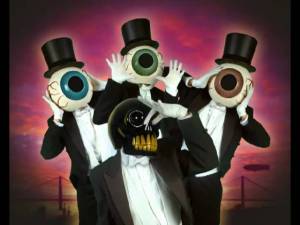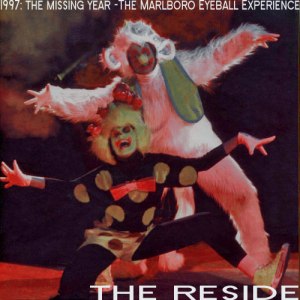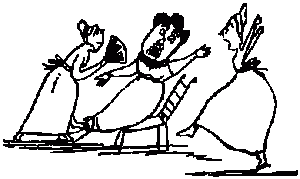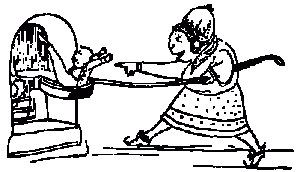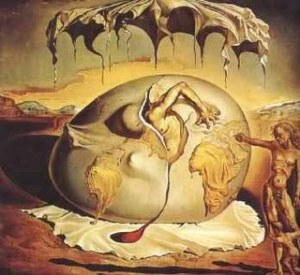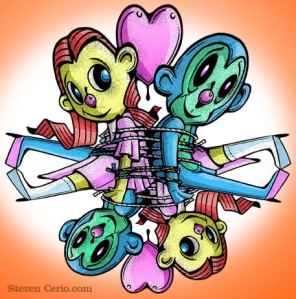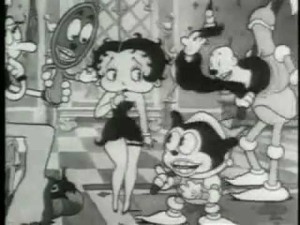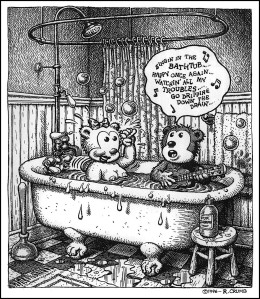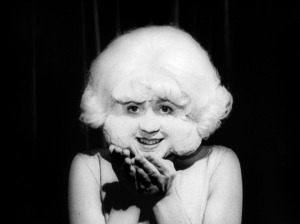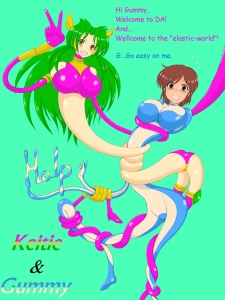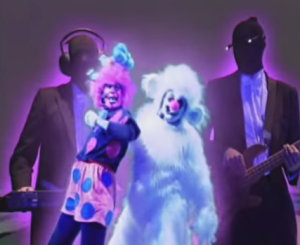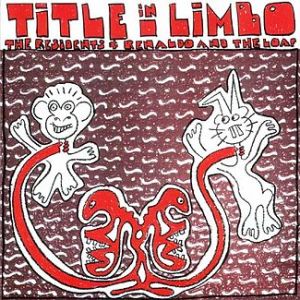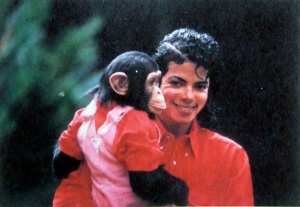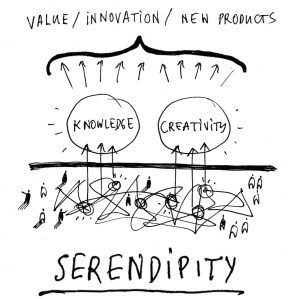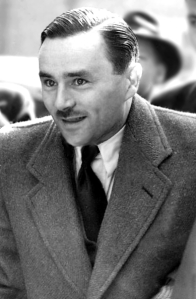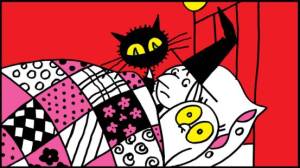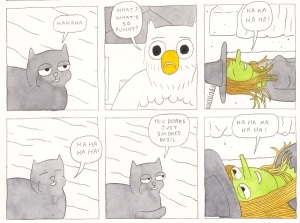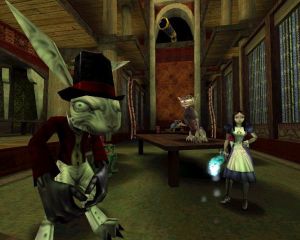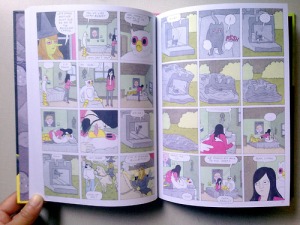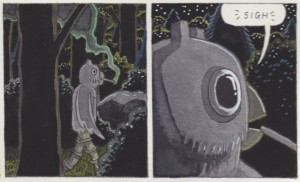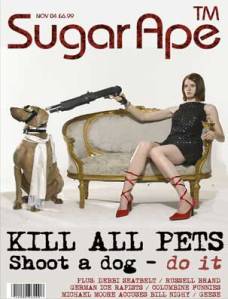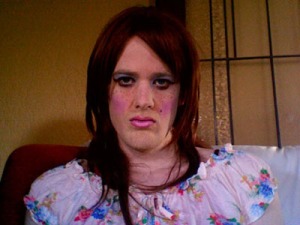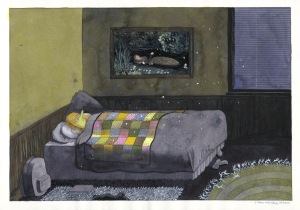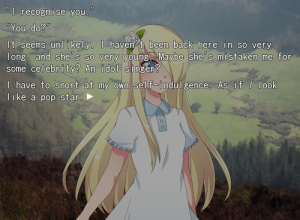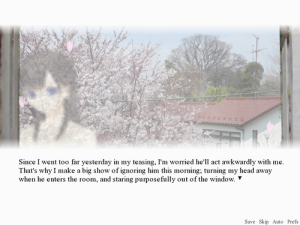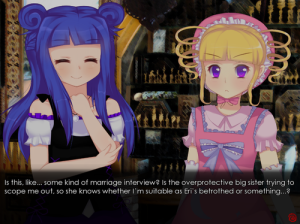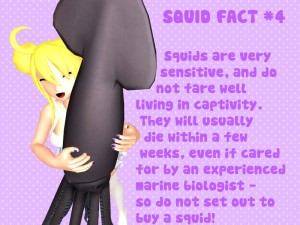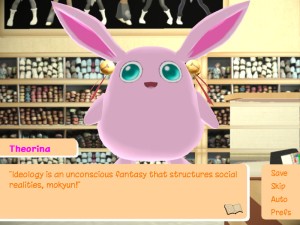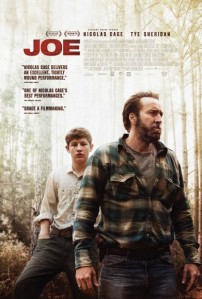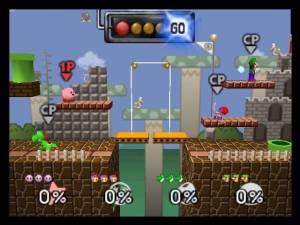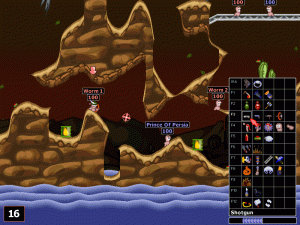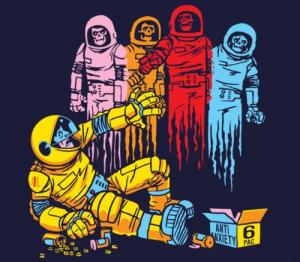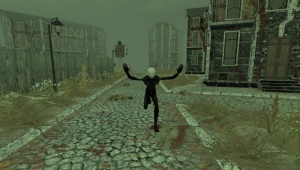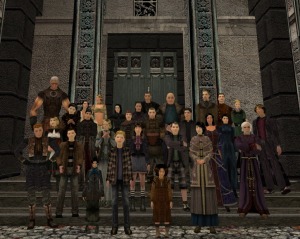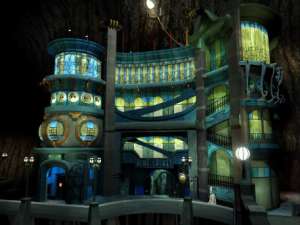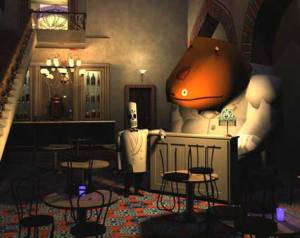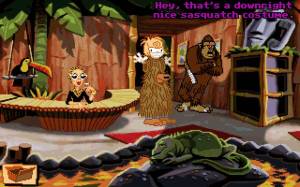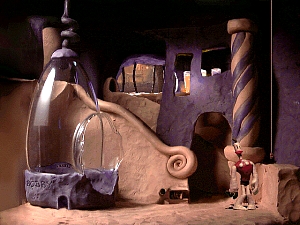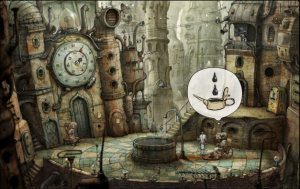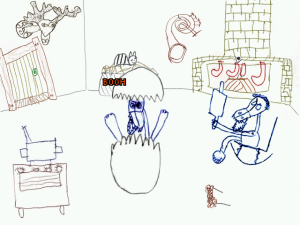Up till yesterday evening I had believed that I had consumed just about every morsel of material produced by avant-garde, eyeball headed, hyper-commercial trickster weirdos The Residents. Though their music is often lumpy and they had almost a decade of mostly producing cover versions of variable quality (approx. 1984-1989, with the glorious exception of God in Three Persons) they have a consistency of vision and imagination that appeals to me. They’re the cracked looking glass for the shallow Hellscape of America!
Plus I just really like cheap synths and MIDI music.
Anyway, this article is unlikely to be of much interest to those without a cursory knowledge of the Residents. However, for a select golden few this might prove something of a minor revelation.
It turns out I hadn’t snaffled up the entirety of the Residents’ back catalogue for I had missed a perverse and compelling performance piece called Disfigured Night – original material devised exclusively for the celebration of their 25th anniversary and a live show at the Fillmore.
Somehow it had completely passed me by, perhaps due to the fact that the pressing was so limited. The 1998 release ran to just 1200 copies. The DVD of the show is equally hard to track down… but-it-seems-maybe-the-Residents-don’t-mind-it-being-viewed-on-Youtube-ever-so-much??? (at the very least the visual artist behind the show doesn’t seem to mind since he links to it from his official site!)
Anyway, Disfigured Night dates from 1997, a little after Molly Harvey had joined the band. The Residents would have been finishing up their multimedia projects (Freak Show, Bad Day on the Midway etc.) several songs from which were featured in the Fillmore show (though it’s exclusively the Disfigured Night section of the show which I am interested in here).
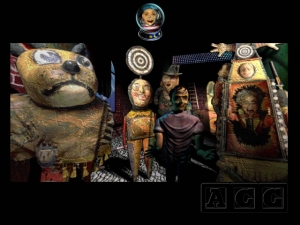
Behind one of the rides in Bad Day on the Midway. An adventure game collaboration with Inscape and my first exposure to the Residents. You explore the titular midway through the perspective of various unhinged characters, jumping between bodies to access different places and gather new insights.
The only other essential track from Live at the Fillmore is the live performance of ’44’ which absolutely eclipses the studio version in ferocity and Molly Harvey witchery:
Live at the Fillmore was released the year before Wormwood, which isn’t an album I have spent much time with — oddly so, considering the fact that I think that Molly Harvey was the Best Thing that happened to the Residents after a rather patchy late 80s / early 90s.
ANYWAY! Disfigured Night is **pretty fantastic** but perhaps more importantly it helps unpack and explain a lot of the Residents’ recurring motifs and themes and works as a neat encapsulation of their career in total.
First, the content. The narrative of Disfigured Night concerns a blissfully innocent naïf called Silly Billy played by Molly Harvey. Like The Who’s ‘Tommy’ Billy is unable to hear or speak. However, while Tommy’s condition is shown to be a coping mechanism in response to trauma (witnessing his father murder his wife’s lover and then being subject to sexual and physical abuse at the hands of an uncle and a cousin, respectively) this situation is reversed in Billy. Every day Billy is assailed by visions of other people’s trauma: a woman’s rape; the suffering of a homeless little girl; the violent death of a sideshow performer. Billy seems to have a psychic connection to other people’s suffering. Yet his comprehension of suffering is limited to the degree that Billy finds these visions entertaining, even comforting; not due to any latent sadism or wickedness, but because his innocence is wholly untouched by evil in any form. The Singing Resident relates: “It even made him happy in a strange and funny way / reversing misery to joy and agony to play” and in an unexpected and beautiful simile describes Billy; “releasing pain as easy as a tree releases birds”.
As such, Billy’s innocence excludes compassion. It is a solipsistic innocence, like that of a baby. As such, Billy problematises the archetype of the magically differently able person… like Tommy he has hidden powers (in this case, a kind of intuitive telepathic ability to channel trauma) bestowed by his disability, but he is not inspirationally disadvantaged. Rather, Billy exists in a pre-lapsarian state outside of morality… which simultaneously might be considered a kind of moral blindness.
It makes absolute sense that the Residents followed this project with an album (Wormwood) that narrates stories from the Bible since the Singing Resident is working in a clearly allegorical mode. Thus, while the use of Billy’s disabilities evoke a certain queasiness in me, I also understand that Billy’s condition is more figurative than literal. Billy is like one of the children who populate William Blake’s Songs of Innocence – he embodies a state of being that is just as much metaphysical than developmental.
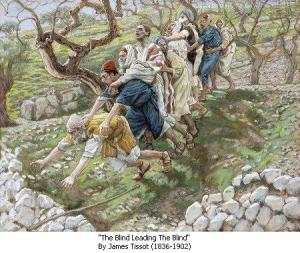
The Bible sometimes uses disability in what I would consider a prejudicial way, but this form of Biblical allegory / moral fable is doubtlessly the mode the Residents are knowingly working within.
What is interesting here is that Billy’s innocence is neither valorised nor demonised – it just is. Billy is situated as part of the natural world, but profoundly alienated from the social world of humans. As noted, the most acute trauma of others appears to him as so many pleasing images, disconnected from narrative or meaning. This leads others to name him “Silly Billy” as the Singing Resident relates: “They called him Silly Billy when they saw his sappy face / but no one knew it came from someone’s less than happy fate.”
Billy’s alienation is depicted in far uglier terms in the song’s opening stanza. Interestingly the lyrical style of this opening (like Victorian nonsense poetry spliced with William Burroughs) is far closer to the kind of lyrics present in much earlier Residents projects, such as Duck Stab or Fingerprince.
We might compared Duck Stab‘s ‘Lizard Lady’:
What she really likes to do is sit upon a pew
And make believe that time has stopped and motionless is new
Planes are stranded in the sky and drains are stopping, too
She alone is laughing under eyelids full of flu
Or Fingerprince‘s Walter Westinghouse:
He buys the bacon, and the achin’
In his heart is due
To overcoats and Quaker Oats
And if his wife should sue.
To Disfigured Night‘s Billy:
Silly Billy bought his breakfast from a fat old man,
who cooked his eggs and bacon in a big black frying pan;
The pan was made of metal that was once an army tank,
holding soldiers with their wounds that oozed until they stank;
And every time the breakfast man put eggs upon his plate,
the yellow yokes stared up as Billy cut them, then he ate.
There’s something ickily primal and sexual about this eggy breakfast.
According to the great sage Wikipedia Salvador Dalí connected eggs “to the prenatal and intrauterine”.
My brother has a phobia of tomatoes. He hates the way their thin, saggy flesh discloses wet mushy pulp. There is something abject about both over-ripe tomatoes and eggs in the way their boundaries are so precarious. They always seem primed to burst or spill outside of themselves.
To quote an evocative snippet of the Cardiacs’ Victory Egg: “Her egg will burst and we’ll arrive.” In fact, several of the Cardiacs’ evocatively infantile lyrics would feel of-a-piece within Disfigured Night… “Stinky Fingers takes chair”; “Come back clammy he reek all lammy”; “Dirty Boy he gone all stale. And down the stair and hallway crawling. And pig and toast and kitchen brawling.” Etc.
Steven Cerio’s art, which is back-projected throughout the performance of Disfigured Night, does a tremendous job at capturing the wee-willy-winkieness (!) – the infantile pre-sexual confused wrongness of the lyrics and imagery of the first part of the show (all egg and visceral nursery rhymes and Silly Billyness).

Steven Cerio’s art is back projected throughout the performance, the drawings loosely following the narrative
I don’t know if there is a word to describe this back-of-your-throat butterflies-in-your-tummy sensation that lies somewhere between budding arousal and trypophobia.
When I was young, on the edge of puberty, I had a dream about befriending a giant plump fly that I had to keep hidden from my family and I kind of wanted to protect and maybe cuddle with this fly and I think I tickled his(?) belly. But he(?) was also a grotesque giant fly. That’s the kind of feeling I’m talking about. In short, the images are gross and weird. In the absence of an actual word in the dictionary that describes what I’m getting at, here are some images that elicit the same feelings in me and hopefully some of you will get where I’m coming from:
Lumpen and scrotal bits (specially noses) in early Chris Ware:
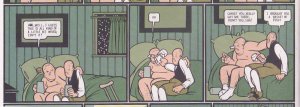
In Ware this is often in relation to father issues. Also when he does the ‘hollow slice of ham’ gawping wounds effect when a character is cut, which is sadly in the following panels.
Rubbery gummy drawings by John “Ren and Stimpy” Kricfalusi, especially when focused on nipples, knees, lips or butts:
- It’s overt here but John K’s stuff always seems sexual to me. AGH THAT BLUBBERY BABY-OLD MAN LIP!!!
Gawping pug-faced bloatyness in Al Columbia. It’s obscene softness:
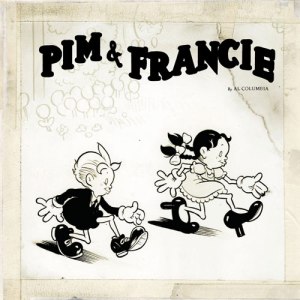
I’m not a complete pervert! I don’t actually find this image appealing. But there is some libidinal and obscene in Al Columbia’s line work.
The bulging and rounded plasticity of Betty Boop and her cronies:
Not all manga or anime by any means, but definitely Junko Mizuno:
Obviously the swollen fleshy fantasies of Crumb:
Certain soft fetishistic visions in David Lynch:
Billy clown sausages?
Furrydom??
THIS 100% 4EVA!!!!!
Look, y’all *know* what I mean by infantile sexuality so I’ll just leave it there. Basically, Disfigured Night has a constant thrumming undercurrent of infantile sexuality provided mainly by Steven Cerio expanding upon some of the latent neuroses bubbling under the lyrics.
These images are spliced, warped, inverted, cut between and overlaid at often overwhelming speeds. The effect is both hypnotic and disorientating, producing sensations of transfixed giddiness and repulsed nausea in equal measure. Sometimes you want to look away, but feel unable to; other time you are stretching your eyes to see the images obscured behind the performers, or forcing yourself to focus in order to simply keep track of the vertiginous wave of visuals. The colours are unabashedly garish and clashing and sometimes the graphic are overlaid to such an extent and at such speed that it is hard to make sense of what you are seeing.
Crudely effective digital wipe effects also make the images fuzz and distort, or run like bleeding paint. At times this even reaches so far as stretching the images until they carpet digital walls like those from the Window 95 maze screensaver:
http://www.clickhole.com/article/house-windows-95-maze-screensaver-sale-1766
Or else the images morph into pixelated landscapes that recall the PS1’s notorious LSD: Dream Emulator:
The performers (Molly Harvey and the Singing Resident / Randy) along with the two musicians are surrounded by a glowing aura of neon pink, making it easier to distinguish them from the backgrounds and adding an nauseous and otherworldly tint to proceedings.
The Singing Resident, who narrates, is dressed as a cross between an organ grinder’s monkey and a circus clown. Indeed, the brief introduction that precedes the performance of Disfigured Night informs the audience that the story is told by the “ghost” of Silly Billy’s pet monkey, who dies during Billy’s journey. So, the monkey occupies a curious position as omnipotent narrator simultaneously involved in the events of the story itself, referring to itself in third person, while we watch the monkey in the present, up to and including the point of it’s death. The monkey-narrator has giant white ears (perhaps reflecting the considerable size of Randy’s own ears) and wears a red waist-coat and a red nose. His fur is white and UV purple and his eyes and mouth are blacked out so in effect he looks like a simian Papa Lazarou:
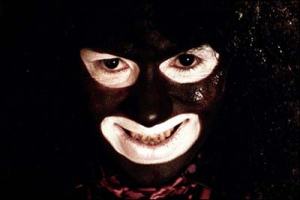
Para Lazarou. Monkey’s makeup similar skirts the line between clown makeup and black face… in this case I believe this says more about the racist origins of Western clowning than it does the Residents, though we might question their use of such iconography.
Silly Billy meanwhile looks like a mime artist’s depiction of a puppy dog crossed with a 1980s disco clown. Molly Harvey wears blue and pink polka-dot shots with black leggings and a black long-sleeved top with pink dots. She has a furry pink wig in which plastic ducks nest and purple and pink face makeup.
To my eyes Silly Billy also looks rather like a Dr. Seuss creation, specifically Things 1 and 2. This certainly lends to the warped cheap children’s show aesthetic on display… although in personality Silly Billy is far more like a wide-eyed Pee-wee Herman or even the typical ‘Everyman’ character from allegory.
Molly Harvey is both charming and frightening in the role of Silly Billy. She has loose-limbed and goofy, yet almost mechanical movements. She often moves slowly with am imbecilic grin upon her face, often sticking out her black painted tongue. She is spruce and knock-kneed as 1920s Mickey Mouse, befittingly wearing a pair of white gloves. Occasionally she stands still as a street performer statue or gurning with jazz hands to her face.
Molly isn’t quite serving the same role here that she does in other Residents’ works. Either she tends to elicit feelings of deep compassion through playing broken and vulnerable characters such as on Demons‘ ‘The Weatherman’ or ‘The Shoe Salesman’ or Animal Lover‘s ‘Inner Space’, childlike innocence with songs like ‘Make Me Moo’ or female power and allure on the likes of Woodworm‘s ‘Burn Baby Burn’ or the scintillating cover of James Brown’s ‘Man’s World’:
Here performance in Disfigured Night evokes a far more ambivalent reaction. It’s utterly charmingly, yet deeply repellent. You simultaneously want to protect, even love, Silly Billy, while also wanting to get as far away from him as humanly possible. It’s like with the giant fly that I tickled. The only other Molly Harvey performance I can think of (and she is remarkably versatile) that comes close to achieving something similar is in Micky Macaroni, which likewise feels as though it has a semi-repressed simmering sexual subtext churning away below things. Odd song with nice taunt Snakefingery guitar:
Back to the plot… In many ways it combines aspects of Not Available, God in Three Persons and anticipates Demons Dance Alone (which is nice as these are basically my three favourite Residents albums!)
It’s a long form narrative like Not Available or Gi3P, almost a mini-opera that focuses upon shifting identities (especially between genders) and the movement from innocence to experience then to absolution. It provides a far more thorough unpacking of the final lines of God in Three Persons:
Pain and pleasure are the twins
That slightly out of focus spins
Around us till we finally realize
That everything that gives us pleasure
Also gives us pain to measure it by.
Musically it has more in common with Demons or Animal Lover (though not as percussive or melodic, perhaps) and shares their concern with humans’ relationship to animals and trauma — particularly what can be done with emotions like loss, fear, pain and rejection and whether they can be transformed into beauty and art. Also, the narrative shares the kind of hyper-real banality that both those albums have, especially Demons.
Occasionally the music becomes a little repetitive or relies too much on keyboard drones, but it has sharp moments of brilliance: a manic, high-pitched ditty that sounds like it’s been rasped out on a tiny toy trumpet, replete with obnoxious Oingo-Boingo style skank beat; an inspired use of the central melody of Queen’s ‘Another One Bites the Dust’; some gratifyingly doomy keyboards and an electric guitar used mainly as a percussive instrument. It is a shame that the music isn’t uniformly excellent or compelling since Randy / Homer(?) offers some of his best lyrics. Lyrically he was clearly on form around this period — the Freak Show album (and CD-ROM) from a few years before Disfigured Night is often too aggressively MIDItastic for my tastes, but contains lyrical gems like:
Half a mouth may not be much
But it’s still half a kiss
Contrariwise there are later albums like Tweedles, which I think are musically sublime, but feature irritatingly crass, even juvenile lyrics that can’t merely be excused as being from the mouth of a warped and unreliable narrator. Tweedles plays with much of the same imagery as Disfigured Night, its main protagonist being a man who wishes to be a clown but has become a sexual predator in response to childhood trauma. It manages the theme of transforming ugliness into beauty with a lot less grace and intelligence than Disfigured Night and, for me at least, only really hits home on the penultimate track ‘Shame on Me’, which is cute-gross in the same way as Disfigured Night and is my second favourite re-purposing of Pachelbel’s Canon after the opening section to Werner Herzog’s The Enigma of Kaspar Hauser (1974).
I am hesitant to reveal too much of the latter plot of Disfigured Night, only to say that Silly Billy comes across a one-legged monkey who he endeavors to return to its owner. His friendship with the monkey opens him to the feeling of compassion, but with it, the experience of suffering. The story ends up taking the form of a journey into darkness and then into light, in which Billy is reconciled with the world and with God.
At once his mind was wild with words that he had never known
defining lines inside the song with light and liquid tones;
He sat up straight and radiated life from far within
the center of his soul where pain and darkness once had been
The Residents seem to respect Oscar Wilde’s maxim: “How else but through a broken heart may Lord Christ enter in?”
Yet there remains an element of mockery. When the mute Billy finally finds his voice he sings the words to Michael Jackson’s charity single for USA Africa We Are the World… but instead of ending on the line “It’s true we’ll make a better day / Just you and me” the Singing Resident repeats the “and me” ad nauseam over and over again until the end, suggesting that at the heart of any charity act will remain a kernel of self interest. As such, it seems as though Billy might not be any wiser, but has come full circle to the position of solipsism that he occupied at the start of his journey.
Yet there remains something perversely moving about the cover of We Are the World as though the Residents are seeking to redeem the ludicrous through making it even more ludicrous. Can one break through the trappings of irony and self-interest to reach something earnest and meaningful? Can one escape one’s childhood sexual neuroses to become a fully actualised human being? Can celebrities only perform in good faith at charity concerts if they hide their identities like the Residents and wouldn’t it be better if the Residents had donated their money from the Fillmore Show to a worthy cause rather than just mocking the likes of Bob Geldof??? Only the Residents know and they ain’t telling!
Finally, Disfigured Night also helps illuminate two perennial Residents obsessions / themes.
Firstly, it solidifies my suspicion that the Singing Resident / Randy / Homer (?) had either a pet or a toy monkey as a child. Growing up in Louisiana it is entirely possible it was the former. I wonder if Randy either mistreated the monkey pet / toy or else it was his earliest attachment object, as evidenced by the lyrics to ‘Monkey and Bunny’ on Title in Limbo and maybe even Animal Lover’s ‘Monkey Man’. Of course, the pet bunny crops up again in The Bunny Boy. Wild speculations perhaps, but I wonder if there isn’t something there…
Secondly, since the concert finishes with a performance of We Are The World by MJ I can’t help but see the titular character of Silly Billy as an avatar for Michael Jackson who, of course, was best friends with a monkey called Bubbles. The lyrics also focus a lot on Silly Billy’s changing face and childlike demeanor.
The artists most explicitly addressed, referenced, covered or even valorised by the Residents (as opposed to merely kitchily mocked) tend to be artists who combine an unbridled passion, joy and childish energy, with more trouble psychosexual neuroses or troubling, even paedophilic or otherwise abusive behaviour. Elvis and Michael Jackson strike me as very similar troubling and troubled figures in some way… there’s something endearing and innocent about both, but at the same time, their fixation upon childhood seems to have been pathological, even sexual. Elvis having pajama parties with 14-year-olds girls, snuggling but never going so far as sex, pretty much encapsulates the man I think.
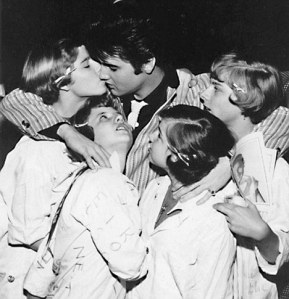
“Elvis played the gentleman, settling for pajama parties where he often styled his new friends’ hair, gave them makeup lessons, or engaged in tickle fights punctuated by kissing.”
The Residents’ Baby King. Pure ID… but in the same way that a child is pure unbridled ID.
I think the reason why Elvis and MJ remain so celebrated and beloved despite these squicky details is 1.) that they were iconic to the point of transcending individual selfhood 2.) that they maintain this kind of child-like purity… there’s something endearingly infantile about them… more cuddly than predatory. Both have Peter Pan syndrome.
I don’t necessarily think it’s the disturbing psychosexual stuff that most interests the Residents (though obviously the libidinal neuroses is there) but the fact that a character like Michael Jackson or Elvis somehow encompasses absolute innocence with absolute experience. The innocence is part of the corruption and the corruption is part of the innocence. Like yin and yang, the black and white are inextricably intertwined. I think this might also be said of James Brown (of whom Randy / Homer in the live version of ‘Life Would be Wonderful’ says meeting was the best day of his life) who was beautiful and joyous and revolutionary, but also a domestic abuser. Same with John Lennon, though the Residents haven’t focused on him so much as the Beatles more generally and often in a mocking and less respectful way.
Anyway, for fans Disfigured Night is well worth watching. Visually it’s fascinating, even beautiful at points in that ugly Residents way, doing very odd things with projection and over-laid images. There’s some obvious Pore No Graphix by Homer and the rest of the art by Steven Cerio is uniformly incredible, goofy yet disquieting.
Molly’s dancing is demented and hilarious. The make-up is astonishingly grotesque. The Singing Resident puts in one of his post bravado vocal performances, kind of like a far more unrestrained and manic version of his narrative voice in God in Three Persons, but with more yelping and snarling.
https://www.youtube.com/watch?v=jl0FoqRyE7A (part 1)
https://www.youtube.com/watch?v=rnRypuBy1eU (part 2)
https://www.youtube.com/watch?v=_wZj9IGKpMM (part 3)
https://www.youtube.com/watch?v=nxEOX4yrCyE (part 4)
Enjoy the goofy melancholia and have a Dr. Seuss inspired existential crisis with the Residents!
